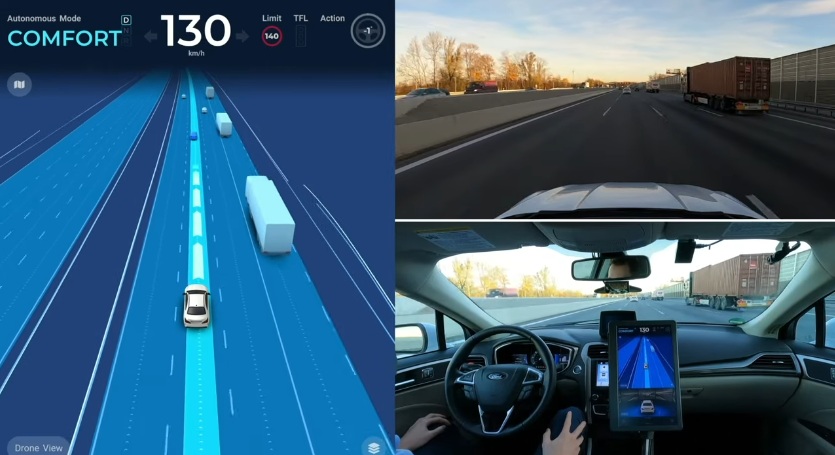Mobileye, Intel’s autonomous driving division, today published an hourlong video of its test vehicle navigating urban and highway driving in Munich, Germany. Mobileye says that it was able to drive autonomously within days of delivering the vehicle thanks to its technology that leverages crowdsourced data to map over 15 million kilometers (~9.32 million miles) of roads daily.
Some experts predict the pandemic will hasten adoption of autonomous transportation technologies. Despite needing disinfection, driverless cars can potentially minimize the risk of spreading disease because of the reduced human interaction. In partnership with Moovit, the mobility-as-a-service startup Mobileye acquired in May for $900 million, Mobileye aims to build full end-to-end ride-hailing experiences with its Luminar lidar-equipped vehicles using Moovit’s platform and apps.
Mobileye says that the video shows its vehicle reaching speeds of up to 130 kilometers per hour (~80 miles per hour) and navigating a left turn on green through an intersection, among other maneuvers. It also avoids an opened car door, a bus pulled to the side of the road, and a vehicle that’s parallel parking; executes an unprotected left turn and lane changes on a highway; and moves around stopped emergency vehicles and down a narrow, congested street.
Mobileye, which Intel acquired for $15.3 billion in March 2017, is building two independent self-driving systems. One is based entirely on cameras, while the second incorporates radar, lidar sensors, modems, GPS, and other components. According to Mobileye, the vehicle shown in the video is using its camera-only subsystem, which runs on two of the company’s EyeQ 5 systems-on-chips processing 11 cameras, along with lidar and radar for redundancy.
Mobileye’s system isn’t unlike Tesla’s Autopilot, which uses eight cameras, 12 ultrasonic sensors, and front-facing radar in tandem with an onboard computer to achieve a level of high-speed autonomy. (Tesla “shadow-tests” its cars’ autonomous capabilities by collecting anonymized data from hundreds of thousands of customer-owned vehicles “during normal driving operations.”) Tesla’s cars, however, omit lidar; CEO Elon Musk has called the laser-based sensors “a crutch.”
In a step toward its ambitious robo-taxi service, Mobileye announced in July that German certification body TÜV Süd awarded it a recommendation for a permit to drive its autonomous vehicles on public roads in the country, enabling it to conduct tests like the one captured in the video. By the end of this year Mobileye expects to scale open-road testing in other countries, including Israel, France, and South Korea.
Mobileye has previously demonstrated that its perception system can detect traffic lights and signs, enabling it to handle intersections fully autonomously. But it also relies on the alluded-to high-definition maps of transportation lines, light rail lines, and roads themselves captured by the company’s Road Experience Management (REM) technology. Harvesting agents, the Mobileye-supplied advanced driver-assistance systems embedded in vehicles from automakers who agree to share data with the company, collect and transmit maps with driving path geometries and stationary landmarks around them. Software running within cars automatically localizes within the maps via real-time detection of recorded, stored, and annotated landmarks.
Mobileye is aiming to deploy robo-taxi fleets in three major cities by 2022, with the hardware cost per robo-taxi coming in at $10,000 to $15,000. By 2025, Mobileye expects to bring the cost of a self-driving system below $5,000. In the interim, the company plans to deploy dozens of vehicles with unrestricted travel between destinations in Israel, followed by a rollout across the country. This could potentially play out alongside the launch of Mobileye’s China-based service in partnership with Beijing Public Transport Corporation and Beijing Beytai.
